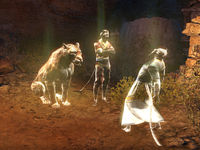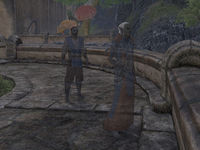Lore:Memory Stone
Memory Stones (or memorystones) are rare magical gems that were used to record and project people's memories. These memories could then be retrieved at a later date by anyone in possession of the stone[1], though some would only function if brought to the location where the memory was originally recorded[2]. The stones themselves are said to emit a faint glow, and distant voices and ghostly images swirl beneath their polished surface.[3][4]
Memory stones were used primarily for archival purposes, allowing the bearer to store their knowledge or memories for future generations. Historians believe there were established scholarly protocols and formalities for recording one's memories into a memory stone, although not everyone who used the stones was familiar with them. Blank memory stones were quite costly - even in ancient times. They were kept well wrapped, sometimes in silver foil, and as soon it touched the bearer's flesh it would begin to record.[1]
Origins[edit]
Memory Stones are believed to originate in Yokuda, and many were brought over to Tamriel during the Ra Gada warrior waves in 1E 808.[5] Yokudan sword-singers were believed to have stored knowledge of various sword techniques into memory stones. This tradition of maintaining "stone-knowledge" was carried on by later generations until at least the Third Era. At least one sword technique, known as Pankratosword, was said to be forbidden by the Yokudans and thus its knowledge was not stored in any stone after the destruction of Yokuda.[UOL 1] Curiously, the destruction of Yokuda itself has been sometimes attributed to the Hiradirge, a renegade band of warriors said to be masters of "stone magic".[5]
Yokudan warriors supposedly carried memory stones into battle, although very few survived in the following centuries.[6] The most notable surviving relic was the Memory Stone of Makela Leki. Makela Leki was an Ansei warrior who succumbed to her wounds after killing King Joile of Daggerfall in the First Era. In her last moments, she recorded memories of her early life and the battle that killed her. Makela's stone was later found in the Bangkorai Pass in 1E 973 and as a result established her as one of Hammerfell's greatest heroes.[1][7]
Centuries later, Makela's stone was stolen by an exiled Redguard warrior named Ulbazar Thief-Lord.[8] He fled Hammerfell and sought refuge in Evermore, only to die after being imprisoned in the city's crypts. In the mid-Second Era, as a favor to King Fahara'jad, High King Emeric sent a detachment to retrieve Makela's stone from the crypts and return it to the Impervious Vault in Sentinel.[9]
Other Uses[edit]
Memory stones can also be magically attuned to the soul of an individual. Doing so allows the stone to summon the echoes of events that occurred at certain locations. The stone then absorbs these echoes and physically projects them in the world, allowing others to view them.[6][10][11] Some scholars believe that Sotha Sil's great orrery of stars, known as the Mnemonic Planisphere, possibly uses manufactured memory stones in some manner to keep his memories stored away.[12]
Gallery[edit]
Notes[edit]
- In the initial draft of Redguards, Their History and Their Heroes in TES II: Daggerfall, the developer gave some background into the concept and original ideas behind Memory Stones. Below are the developer notes extracted from the data files. While much of this didn't make it into the final version, its included here for completeness:
-
- The memory stone mentioned in the second chapter may not be familiar to all readers. It is a stone who's mineral content makes it only found in the far north of High Rock, and there are few of them to begin with. At one time, there was a Mage that lived in the vastness and wastes of that region, and he in practicing enchantment spells, imbued several hundreds of them with the ability to hold and record one's thoughts. They are extremely valuable and can be used to record only once. Most city museums hold a dozen or so of these stones, and if you take one in your hand, you can receive the thoughts of the original owner as clear and fresh as if they were speaking to you. Now days un-recorded stones are very rare, and worth far more than in Makela's day. Imagine she paid only 25,000 gold crowns for hers!
References[edit]
- ^ a b c From The Memory Stone of Makela Leki — Makela Leki
- ^ Faric Gemain's dialogue in, and events of, Haunted Legacy
- ^ Marzula-jo's Memory Stone quest item in ESO
- ^ Cracked Yokudan Memory Stone contraband item in ESO
- ^ a b Pocket Guide to the Empire, 3rd Edition: Other Lands — Imperial Geographical Society, 3E 432
- ^ a b Gilan Lerano's dialogue in ESO
- ^ Makela Leki's dialogue in ESO
- ^ Makela Leki's Memory Stone quest item in ESO
- ^ A Favor Between Kings quest in ESO
- ^ The Memory Stone quest in ESO
- ^ Kireth's Memory Stone quest item in ESO
- ^ Mnemonic Star-Sphere antiquity codex entry in ESO
Note: The following references are considered to be unofficial sources. They are included to round off this article and may not be authoritative or conclusive.
|
||||||||||||||||||||||||||||||||||||||


